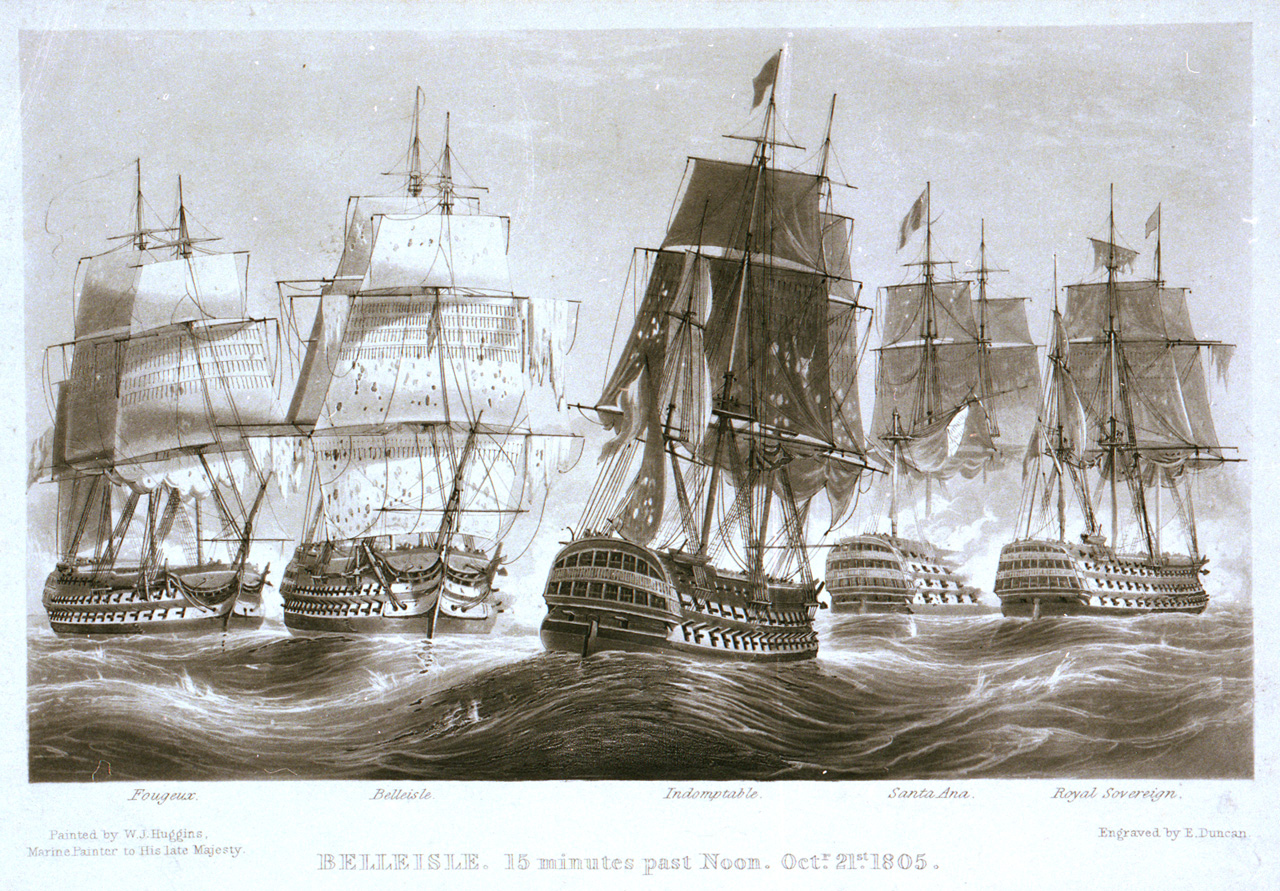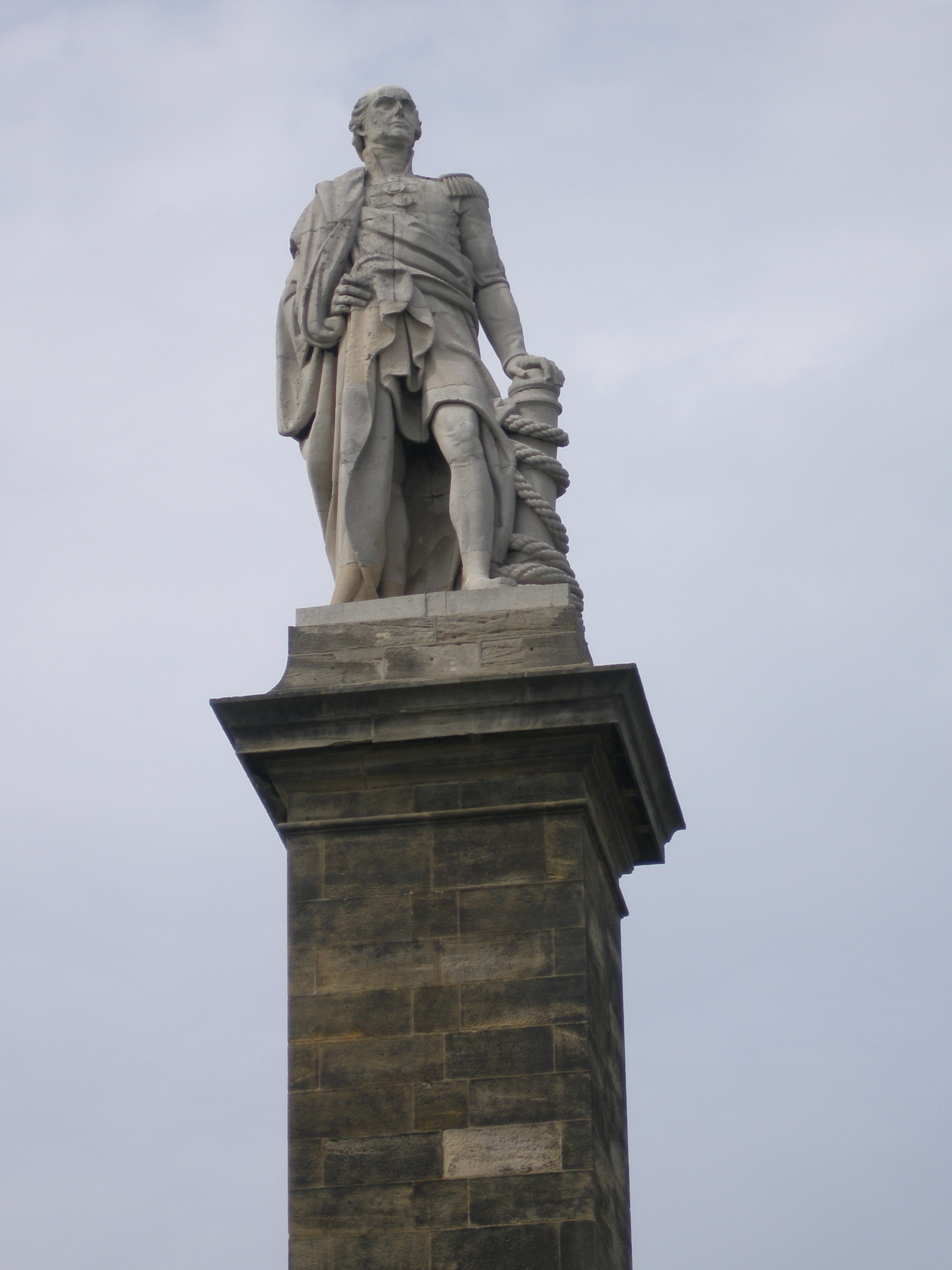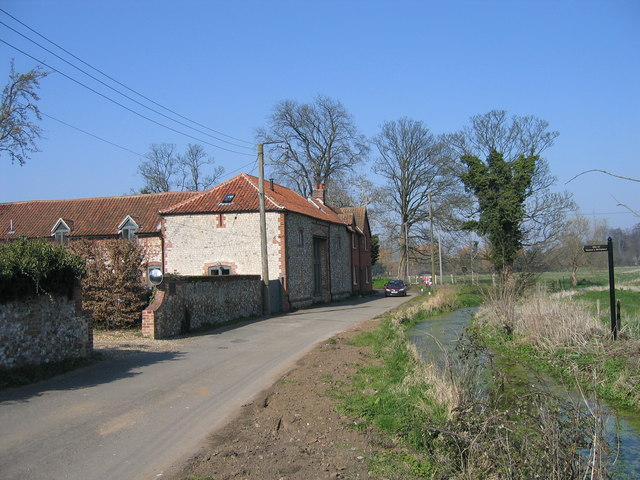|
George Duff
Captain George Duff RN (c. 1 February 1764 – 21 October 1805) was a British naval officer during the American War of Independence, the French Revolutionary Wars and the Napoleonic Wars, who was killed by a cannonball at the Battle of Trafalgar. Early life Born at Banff, Scotland, the son of Banff Sheriff Clerk James Duff (1729–1804) by his marriage to Helen Skene 1734–1764, he was a kinsman (first cousin once removed) to the second and third Earls of Fife. George Duff had a passion for the sea from early childhood, stowing away on a merchant ship for a voyage when not yet a teenager. At thirteen he joined his great uncle Captain (later Admiral) Robert Duff in the Mediterranean, and was commissioned lieutenant at sixteen, breaking several fleet regulations but made possible by his uncle's interest in his career. During these years, Duff saw action thirteen times on both sides of the Atlantic, including at the Great Siege of Gibraltar and culminating in the battle ... [...More Info...] [...Related Items...] OR: [Wikipedia] [Google] [Baidu] |
William Hennah
Captain William Hennah (January 1768 – 23 December 1832) was British naval officer, whose largely undistinguished career was suddenly highlighted by his assumption of command of HMS ''Mars'' at the Battle of Trafalgar in 1805 upon the death of that ship's captain, George Duff, who was decapitated by a cannonball. Early career Hennah was born in January 1768 and baptised on the 7th, the son of Richard Hennah, the vicar of St Austell in Cornwall.Hore p. 145 He joined the navy because of his Cornish hero, the circumnavigator Samuel Wallis, and was entered as captain's servant to Philip Walsh of , in 1778. In March 1779 Hennah was rated as midshipman. He passed the lieutenant's exam at the beginning of January 1788 but was not promoted until the general round of promotions at the outbreak of the French Revolutionary War in 1793. Hennah had little opportunity for distinction until 1800, when he participated in a boat raid on the Morbihan river in which the French corvette ''Rél ... [...More Info...] [...Related Items...] OR: [Wikipedia] [Google] [Baidu] |
Henry Raeburn
Sir Henry Raeburn (; 4 March 1756 – 8 July 1823) was a Scottish portrait painter. He served as Portrait Painter to King George IV in Scotland. Biography Raeburn was born the son of a manufacturer in Stockbridge, on the Water of Leith: a former village now within the city of Edinburgh. He had an older brother, born in 1744, called William Raeburn. His ancestors were believed to have been soldiers, and may have taken the name "Raeburn" from a hill farm in Annandale, held by Sir Walter Scott's family. Orphaned, he was supported by William and placed in Heriot's Hospital, where he received an education. At the age of fifteen he was apprenticed to the goldsmith James Gilliland of Edinburgh, and various pieces of jewellery, mourning rings and the like, adorned with minute drawings on ivory by his hand, still exist. When the medical student Charles Darwin died in 1778, his friend and professor Andrew Duncan took a lock of his student's hair to the jeweller whose apprentice, Raebu ... [...More Info...] [...Related Items...] OR: [Wikipedia] [Google] [Baidu] |
Battle Of The Saintes
The Battle of the Saintes (known to the French as the Bataille de la Dominique), also known as the Battle of Dominica, was an important naval battle in the Caribbean between the British and the French that took place 9–12 April 1782. The British victory was considered their greatest over the French during the American Revolutionary War. The British fleet under Admiral Sir George Rodney defeated a French fleet under the Comte de Grasse, forcing the French and Spanish to abandon a planned invasion of Jamaica. The battle is named after the Îles des Saintes, a group of small islands between Guadeloupe and Dominica in the West Indies. The French had blockaded the British Army at Chesapeake Bay the year before, during the Siege of Yorktown, and supported the eventual American victory in their revolution. This battle, however, halted their momentum and had a significant effect on peace negotiations to end the war. The French suffered heavy casualties at the Saintes and many w ... [...More Info...] [...Related Items...] OR: [Wikipedia] [Google] [Baidu] |
French Ship Pluton (1805)
''Pluton'' was a 74-gun French ship of the line built at Toulon. She was one of two prototypes for a derivative sub-class of the original design; this sub-class (slightly smaller than the primary design) was specially intended for construction in some of the shipyards in states occupied by the French, where there was less depth of water than in the main French shipyards. Although the ''Pluton'' (and her sister, the ''Borée'') were built at Toulon, all other vessels of this sub-class were built in these overseas yards, notably at Antwerp but also at Genoa, Trieste, Venice, Amsterdam, Flushing and Rotterdam. The ''Pluton'' took part in the Battle of Trafalgar under Captain Julien Cosmao-Kerjulien, and escaped to Cádiz with other ships. Two days later, on 23 October 1805, she was the flagship of the counter-attack from Cádiz, together with , , and . They managed to recapture the and . To prevent their recapture, the British scuttled the and . ''Rayo'' and ''San Francisco de ... [...More Info...] [...Related Items...] OR: [Wikipedia] [Google] [Baidu] |
French Ship Fougueux (1785)
''Fougueux'' was a 74-gun French ship of the line built at Lorient from 1784 to 1785 by engineer Segondat. Ship history In 1796, she took part in the Expédition d'Irlande under Esprit-Tranquille Maistral. She took part in the Battle of Trafalgar, firing the first shot of the battle upon . She later attempted to come to the aid of the by engaging . After badly damaging the ''Fougueux'' with broadsides, ''Temeraire''s first-lieutenant, Thomas Fortescue Kennedy, led a boarding party onto ''Fougueux'', entering the French ship via her main deck ports and chains. The French tried to defend the decks port by port, but were steadily overwhelmed. ''Fougueux''s captain, Louis Alexis Baudoin Louis Alexis Baudoin (Saint-Jean-d'Angély, 2 December 1776 — ''Fougueux'', off Trafalgar, 21 October 1805Quintin, pp. 50–51) was a French Navy officer and captain. Career After sailing on merchantmen, Baudouin joined the Navy as a temporar ..., had suffered a fatal wound earlier in t ... [...More Info...] [...Related Items...] OR: [Wikipedia] [Google] [Baidu] |
Midshipman
A midshipman is an officer of the lowest rank, in the Royal Navy, United States Navy, and many Commonwealth navies. Commonwealth countries which use the rank include Canada (Naval Cadet), Australia, Bangladesh, Namibia, New Zealand, South Africa, India, Pakistan, Singapore, Sri Lanka, and Kenya. In the 17th century, a midshipman was a rating for an experienced seaman, and the word derives from the area aboard a ship, amidships, either where he worked on the ship, or where he was berthed. Beginning in the 18th century, a commissioned officer candidate was rated as a midshipman, and the seaman rating began to slowly die out. By the Napoleonic era (1793–1815), a midshipman was an apprentice officer who had previously served at least three years as a volunteer, officer's servant or able seaman, and was roughly equivalent to a present-day petty officer in rank and responsibilities. After serving at least three years as a midshipman or master's mate, he was eligible to take ... [...More Info...] [...Related Items...] OR: [Wikipedia] [Google] [Baidu] |
Cuthbert Collingwood
Vice Admiral Cuthbert Collingwood, 1st Baron Collingwood (26 September 1748 – 7 March 1810) was an admiral of the Royal Navy, notable as a partner with Lord Nelson in several of the British victories of the Napoleonic Wars, and frequently as Nelson's successor in commands. Early years Collingwood was born in Newcastle upon Tyne. His early education was at the Royal Grammar School, Newcastle. At the age of 12, he went to sea as a volunteer on board the sixth-rate under the command of his cousin Captain Richard Brathwaite (or Braithwaite), who took charge of his nautical education. After several years of service under Brathwaite and a short period attached to , a guardship at Portsmouth commanded by Captain Robert Roddam, Collingwood sailed to Boston in 1774 with Admiral Samuel Graves on board , where he fought in the British naval brigade at the Battle of Bunker Hill in June 1775, and was afterwards commissioned as a lieutenant on 17 June. In 1777, Collingwood met Hora ... [...More Info...] [...Related Items...] OR: [Wikipedia] [Google] [Baidu] |
Alexander Hood (captain)
Captain Alexander Hood (23 April 175821 April 1798) was an officer of the Royal Navy, one of several members of the Hood family to serve at sea, including his brother Sir Samuel Hood, who were both sponsored into the Royal Navy by their cousins once removed, Viscount Hood and Alexander Hood. Career He entered the Royal Navy in 1767, and accompanied Captain James Cook in his second voyage of exploration from 1772 to 1775. During the American Revolutionary War, under Admirals Richard Howe and George Rodney, when he had command of the cutter ''Ranger'' in March 1780, he distinguished himself in the West Indies, and in July 1781 at the age of 23 he was promoted to captain. Shortly thereafter, he was given command of the 98-gun second rate ship of the line, . It was not uncommon for an extremely junior captain to find himself commanding a large ship-of-the-line, if that ship were the flagship of an experienced admiral, who would be able to keep a close eye on the new captain. In th ... [...More Info...] [...Related Items...] OR: [Wikipedia] [Google] [Baidu] |
French Ship Hercule (1797)
HMS ''Hercule'' was a 74-gun third rate ship of the line of the Royal Navy. She was previously ''Hercule'', a ship of the line of the French Navy, but was captured on her maiden voyage in 1798, and spent the rest of her career as a British ship. She was broken up in 1810. French career and capture During her maiden journey, on 21 April 1798, and just 24 hours out of port, she was captured by the British ship after a violent fight at the Battle of the Raz de Sein, off Île de Sein near Brest. ''Hercule'' attempted to escape through the Passage du Raz, but the tide was running in the wrong direction, and she was forced to anchor, giving the British the chance to attack at close quarters. The two ships were of equal force, both seventy-fours, but ''Hercule'' was newly commissioned; after more than an hour and a half of bloody fighting at close quarters she struck her colours at 10.30 pm, having lost — by her own officers' estimate — 290 men killed and wounded. On ''Mar ... [...More Info...] [...Related Items...] OR: [Wikipedia] [Google] [Baidu] |
Peace Of Amiens
The Treaty of Amiens (french: la paix d'Amiens, ) temporarily ended hostilities between France and the United Kingdom at the end of the War of the Second Coalition. It marked the end of the French Revolutionary Wars; after a short peace it set the stage for the Napoleonic Wars. Britain gave up most of its recent conquests; France was to evacuate Naples and Egypt. Britain retained Ceylon (Sri Lanka) and Trinidad. It was signed in the city of Amiens on 25 March 1802 (4 Germinal X in the French Revolutionary calendar) by Joseph Bonaparte and Marquess Cornwallis as a "Definitive Treaty of Peace". The consequent peace lasted only one year (18 May 1803) and was the only period of general peace in Europe between 1793 and 1814. Under the treaty, Britain recognised the French Republic. Together with the Treaty of Lunéville (1801), the Treaty of Amiens marked the end of the Second Coalition, which had waged war against Revolutionary France since 1798. National goals Great Britain ... [...More Info...] [...Related Items...] OR: [Wikipedia] [Google] [Baidu] |
Horatio Nelson
Vice-Admiral Horatio Nelson, 1st Viscount Nelson, 1st Duke of Bronte (29 September 1758 – 21 October 1805) was a British flag officer in the Royal Navy. His inspirational leadership, grasp of strategy, and unconventional tactics brought about a number of decisive British naval victories during the French Revolutionary and Napoleonic Wars. He is widely regarded as one of the greatest naval commanders in history. Nelson was born into a moderately prosperous Norfolk family and joined the navy through the influence of his uncle, Maurice Suckling, a high-ranking naval officer. Nelson rose rapidly through the ranks and served with leading naval commanders of the period before obtaining his own command at the age of 20, in 1778. He developed a reputation for personal valour and firm grasp of tactics, but suffered periods of illness and unemployment after the end of the American War of Independence. The outbreak of the French Revolutionary Wars allowed Nelson to return to se ... [...More Info...] [...Related Items...] OR: [Wikipedia] [Google] [Baidu] |





.jpg)

